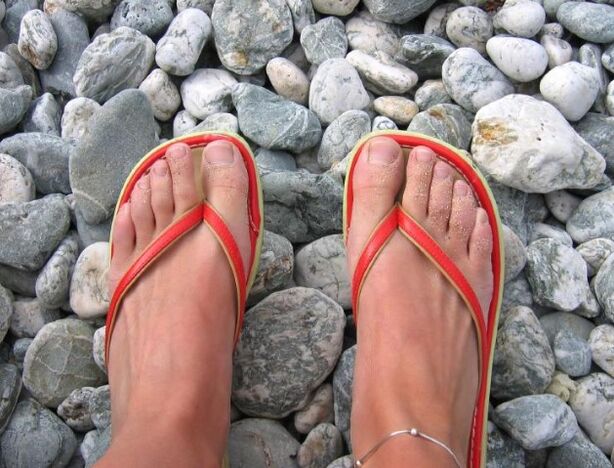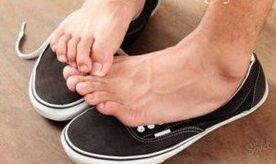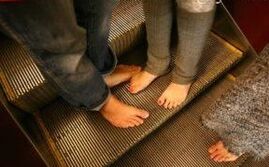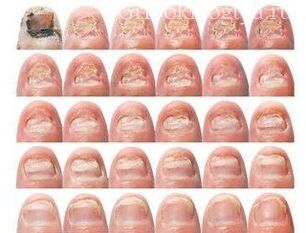Nail fungus is a rather dangerous phenomenon that can progress, destroying all nails. In the early stages of development, the sponge may be invisible to the eye, but its negative effect on the nail structure is enhanced daily. How to identify nail fungus ourselves and how to treat it, given the stage of the disease, we will analyze further.

There are a number of signs that help determine the presence of fungal nail lesions:
- Loosen the nail - you can check when to cut the edge of the nail. If the nail breaks down in the process, not cut, it is the first symptom of the presence of a fungus and a clear reason to visit a doctor.
- The nail thickening, mainly at the edge-hyperkeratosis (sealing), occurs due to the harmful effects of the fungi, which can disrupt the integrity of the nail fibers, which is why the latter change in high quality and quantitative form.
- The implementation of the nail and its cutting under the skin - such a phenomenon can provoke not only the wearing of tight shoes, but also the fungal lesions that change the nail plate, providing the wrong location.
- The change in the color of the nail (from pale yellow to brown) - occurs as a result of the destruction of the active components of the nails and the folding of protein cells during destruction.
- The presence of a white plaque - fungal spores penetrate deep into the root of the nail, as well as on the surface, which is dangerous for the extensive infection of all fingers.
The first signs that the nail has lost its health and has problems caused by the active activity of mushrooms are:
- loss of shine and surface shine;
- slightly yellowing of the nail;
- Extensive itching of the entire leg, the appearance of red spots filled with transparent fluid;
- unpleasant leg odor, especially after abundant sweating;
- Crossing the skin of heels and soles, wide -ranging.
These symptoms show different leg problems, so it is better not to neglect your doctor's consultation. Early diagnosis greatly facilitates the treatment process by ensuring complete recovery.

Foot legs: Norm and deviation
To exclude or identify the presence of fungal diseases, you need to examine your own feet, toes and nails. The following indicators must be supported:
- The foot of the feet is smooth, without calluses, calluses and seals.
- The skin of the feet is the same, without cracks and spots.
- There is no redness and itching, especially between the fingers.
- The nails are flat, plain, transparent.
- The nail bed, the surface with a gloss is well visible.
If there are deviations from the stated standards and the legs have an unpleasant pungent odor, medical consultation and a study of the presence of the pathogen.
Risk factors for the development of fungus on the feet
Fungi infection can occur in absolutely any place, including home slippers. So this happens enough to have:
- weak immunity that is unable to limit the active reproduction of mushrooms;
- increased sweating of the legs due to incorrectly selected and poor quality of shoes;
- the presence of cuts in the nail area with unsuccessful nail or cuticles;
- insufficient foot hygiene as well as shoes;
- A frequent visit to public places where there is a high risk of infection: urban baths, saunas, solarium, pool, local beach;
- Excessive use of cosmetics (lacquers, nail extensions, refreshing sprays and leg gels) that lead to the death of local immunity.
Different types of mushrooms have a different latent period during which the disease does not manifest itself.
You can get infected with a sponge in two ways:
- Contact - through direct contact from sick person to healthy: personal hygiene items, public places, wearing foreign shoes.
- In contact - the infection occurs due to the active development of those mushrooms that are in the body of each person. In certain situations (such as a sharp decrease in immunity), their number increases and cannot be completely controlled by the body independently.
Most often, people in the following categories are subject to fungal lesions:
- Children with a smaller layer of skin;
- people suffering from HIV infection;
- with increased sweating of the legs;
- The presence of chronic diseases that inhibit the immune system.

If there are above indicators, the condition of the toenails and the braking is generally required to be carefully monitored, paying due attention to the hygiene.
Differentiation of nail fungal disease
In medicine, the concept of "fungal damage to the nail" is collective as mushrooms of different species can act as a pathogen. Most often such mushrooms are found on the toenails such as:
- Dermatophytes - a group of mushrooms that appear in the form of yellow spots or white vertical stripes. The infected nail gradually loses its strength and shape, after which the cavity becomes lifeless and easily removed from the nails.
- Yeast lesions - occur as a result of the active activity of Candida mushrooms. The nail itself is smaller, and the roller of the Dealini blushes and swells. It can manifest itself as an independent disease with frequent prolonged colds and weakened immunity.
- Forms - are located mainly on the surface of the nail, changing its color to a greenish, brownish or whitish shade.
It is impossible to determine the causative agent of the fungal disease alone, since the same fungi, when exposed to different aggregated factors, may manifest differently. Accordingly, it is impossible to initiate treatment as each type of mushroom has its own antifungal drugs that adversely affect the life of pathogens. Therefore, when you diagnose the smallest abnormalities from the norm, you should consult a doctor and take a test for the presence of a fungus.
Stages of fungal damage to the legs
The process from the moment of infection to the complete destruction of the nails is called the stages of the course of the disease. Select them 5:
- Infection - The fungus enters the surface of the nail, dipping through the cuticle in the nail.
- The incubation period (from 3 days to 5 months) - the activity of the mushrooms is minimal, but it increases at lightning speed when all conditions are designed to do so: the immunity is weakened, there is a wet warm environment, there is no appropriate hygiene. Externally, the incubation period does not manifest itself in any way.
- The initial stage - the number of mushrooms is so large that it can have a negative effect on the viability of the nail. The ends of the nails gradually turn yellow from the edge to the nail bed. The nail acquires a matte shade, disappears pink healthy color, the gloss disappears from the surface. In this case, dry skin is noted on the toes.
- The stage of the active course - the mushroom population reaches the maximum, which allows you to infect other nail plates by obtaining disputes through contact. Hyperkeratosis is enhanced - increased production of keratin fibers, under the influence of fungal activity. In this case, the nail is compacted, noticeably protruding above the surface of the finger.
- The last stage - is determined by the murder of the nails as a result of the lesion not only of the nail, but also by the nearby soft tissues. The entire surface of the nail has a yellow or brown shade, the cut is noted with a laxity, which is accompanied by painful sensations.
With a large large -scale infection, local symptoms can also join:
- Dysbiosis in the form of stool disorder;
- fever;
- Leg pain, intensification during movement;
- Confession connection.
All above manifestations help to determine the stage of onychomycosis. To identify the pathogen, you will need to do a special analysis showing the exact genus and the type of fungi that provoke onychomycosis.
How and what to treat

You need to understand that the key to successful treatment is the right diagnosis, which is impossible to make at home at home. Only a doctor based on the results of the analysis is able to identify a genus of mushrooms and to choose the right treatment.
For many, it remains a mystery why, the antifungal medicine purchased at a pharmacy does not help. There are many reasons and explanations for this. First, initially the antifungal drug is chosen on the basis of the generator. Second, the treatment of fungi is a complex event consisting of:
- Local therapy - administration of antifungal medicines on the surface of the nail.
- Oral antifungal tablets that can suppress the development of fungi and reduce their number from the inside.
- Imastimulating drugs that "force" the body to produce a sufficient number of immune carts that independently fight the fungi.
- Observance of the hygiene of the legs-the leaf is washed 2-3 times a day, with cool water and soap, then wiped dry with a towel. Cut the nail every 3-5 days.
- Wearing shoes made of real leather as well as cotton linen.
After turning off at least one of these 5 points, the recovery process will be dragged for many months or even fail. Only complete treatment will allow you to completely get rid of the fungi, as well as to exclude the risks of recurrence.
The recipes for traditional medicine, which are so difficult to cure nail fungus, in most cases are ineffective. The result will only appear when the above recommendations for combating fungal nail lesions will be added.
This is not difficult to determine the presence of a fungus on the toenails. It is enough to check the nails and all the fingers as a whole, comparing them to photos showing the presence of a sponge. Treatment is considered effective and correct only when performed under the control of specialists. Suicide can cause many negative health effects, as well as complicate more treatment of the disease.
















